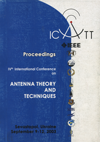GPR antenna simulations and optimizations in time domain
DOI:
https://doi.org/10.1109/ICATT.2003.1239143Keywords:
transient antennas, finite difference time-domain analysis, GPR, ground penetrating radarAbstract
The development and optimization of transient antennas for ground penetrating radar would be difficult without numerical simulations of their performance. To this end the FDTD algorithm should be considered as a useful and powerful tool for transient antenna analysis. As an example of such analysis we describe simulations of the dielectric wedge antenna. Good agreement between theoretical predictions and experimental results was observed. Some of the antenna characteristics (like the radial component of the electric field in the near zone, the radiated waveform and the antenna footprint in different grounds) cannot be measured easily, so the correct theoretical (numerical) model is essential for their determination. The numerical model of the antenna can also be used for optimization of the antenna. As an example of such optimization we present a design of the shield for the dielectrically embedded dipole antenna.References
Daniels, D.J., Surface-Penetrating Radar, London: The Inst. Electrical Eng., 1996.
Foster, P.R. CAD for Antenna System. Electronics and Communication Engineering J., 2000, No. 2, p. 3-14.
Jongh, R.V. de; Yarovoy, A.G.; Ligthart, L.P.; Kaploun, I.V.; Schukin, A.D. Design and analysis of new GPR antenna concepts. Proc. Seventh Int. Conf. on Ground Penetrating Radar, 1998, Vol. 1, pp. 81-86.
Leat, C.J.; Shuley, N.V.; Stickley, G.F. Complex Image Model for Ground-Penetrating Radar Antennas. IEEE Trans. Antennas Propagation, 1998, Vol. AP-46, No. 10, pp. 1483-1488.
Lestari, A.A.; Yarovoy, A.G.; Ligthart, L.P. Numerical Analysis of Transient Antennas. Proc. Int. Conf. on Electromagnetics in Advance Applications, (ICEAA'Ol), Torino, Italy, Sept. 10-14, 2001. 2001, pp. 435-438.
Mur, G. Total-Field Absorbing Boundary Conditions for the Time-Domain Electromagnetic Field Equations. IEEE Trans. Electromagnetic Compatibility, 1998, Vol. EMC-40, No. 2, pp. 100-102.
Mur, G. FDTD3D: the Time-Domain Finite-Difference Code in C++. IRCTR Technical Report, Delft University of Technology, 1999, 71 p.
Rao, S.M.; Wilton, D.R. Transient Scattering by Conducting Surfaces of Arbitrary Shape. IEEE Trans. Antennas Propagation, 1991, Vol. AP-39, No. 1, pp. 39-56.
Schlager, K.L.; Smith, G.S.; Maloney, J.G. Optimization of Bow-Tie antenna for Pulse Radiation. IEEE Trans. Antennas Propagat., 1994, Vol. AP-42, No. 7, pp. 975-982.
Taflove, A. Computational Electrodynamics: the finite-difference time-domain method. Artech House, 1995.
Wagner, C.L.; Schneider, J.B. Divergent Fields, Charge, and Capacitance in FDTD Simulations. IEEE Trans. Microwave Theory and Techniques, 1998, Vol. MTT-46, No. 12, Parti, pp. 2131-2136.
Yarovoy, A.G.; Schukin, A.D.; Ligthart, L.P. Development of Dielectric Filled TEM-Horn. Proc. on Millennium Conference on Antennas & Propagation, Davos, Switzerland, 9-14 April 2000.
Yarovoy, A.G.; Schukin, A.D.; Kaploun, I.V.; Ligthart, L.P. The Dielectric Wedge Antenna. IEEE Trans. Antennas Propagation, 2002, Vol. AP-50, pp. 1460-1472.

